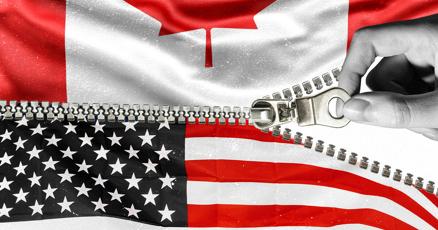The economic dance between Canada and the United States has always been a delicate one, but recent developments suggest we’re entering a new, more complicated phase in this relationship. As America’s protectionist stance solidifies under the banner of “America First” policies, Canada finds itself at a critical juncture—one that demands not just tactical responses but a fundamental reimagining of our trade strategy.
For decades, we’ve operated under the assumption that free trade would naturally benefit both nations. The reality has proven more complex. American policy has shifted dramatically toward protecting domestic industries, implementing tariffs, and prioritizing national economic interests with an unprecedented aggressiveness. This isn’t simply a temporary deviation—it represents a structural change in how our largest trading partner views economic relationships.
The numbers tell a sobering story. Canada exports approximately 75% of its goods to the United States, creating an inherent vulnerability that becomes painfully apparent whenever Washington decides to flex its economic muscle. Recent disputes over softwood lumber, aluminum, and dairy products demonstrate how quickly Canadian industries can find themselves on the defensive when American policy shifts.
What’s particularly concerning is that this protectionist approach transcends political parties in the U.S. While the previous administration may have initiated many of these measures, the current one has maintained most of them, suggesting this isn’t a partisan aberration but a new American consensus. Both Democrats and Republicans have embraced economic nationalism as a core principle, leaving Canada with few reliable allies in Washington.
“The era of trade policy based primarily on goodwill and historical alliances is over,” explains Dr. Margaret Chen, international trade specialist at the University of Toronto. “Canada needs to acknowledge this new reality and adapt its approach accordingly.”
Adaptation, in this context, doesn’t mean capitulation. Rather, it requires a more strategic, forward-thinking approach to economic sovereignty. For too long, Canadian policy has been reactive—responding to American decisions rather than proactively building resilience into our economic structures. Our traditional diplomatic toolkit of appealing to fairness, mutual benefit, and historical friendship is increasingly ineffective against an American political system that prioritizes domestic interests above all else.
The path forward requires several simultaneous initiatives. First, diversification of trade relationships beyond North America remains crucial. The Comprehensive Economic and Trade Agreement (CETA) with the European Union and the Comprehensive and Progressive Agreement for Trans-Pacific Partnership (CPTPP) represent important steps, but implementation and expansion of these agreements must accelerate.
Second, Canada must invest more heavily in sectors where it maintains competitive advantages. Clean energy, advanced manufacturing, digital services, and biotechnology offer opportunities to develop industries that are less vulnerable to protectionist measures. This isn’t simply about economic growth—it’s about building leverage in future negotiations.
Third, domestic policy must align with international strategy. Tax structures, regulatory frameworks, and investment incentives should all support a more resilient, innovative economy. The days of assuming access to the American market will compensate for domestic policy shortcomings are over.
Perhaps most importantly, Canada needs to approach trade disputes with greater strategic clarity. Fighting every battle with equal vigor dilutes our influence and exhausts diplomatic capital. Some issues warrant full engagement; others might be better addressed through alternative mechanisms or even strategic concessions that secure advantages elsewhere.
“The key is to be selective and strategic,” notes former Canadian ambassador to the U.S., David MacNaughton. “We need to identify our true economic priorities and focus our efforts accordingly.”
This doesn’t mean abandoning the principles of free trade or the valuable relationship with our southern neighbor. Rather, it means engaging with the United States from a position of greater strength and independence—demonstrating that while we value the relationship, we’re prepared to pursue our interests through multiple channels.
The changing landscape of Canada-U.S. trade relations presents both challenges and opportunities. By acknowledging the fundamental shift in American approach, developing greater economic resilience, and engaging more strategically in trade disputes, Canada can navigate this new terrain more effectively.
The question isn’t whether Canada can maintain its economic relationship with the United States—it’s whether we can transform that relationship into one that better serves our long-term national interests in an era of increased economic nationalism. The answer will shape
























